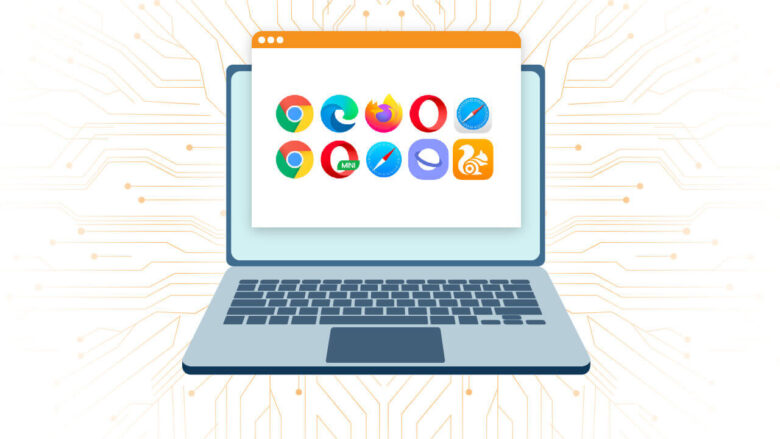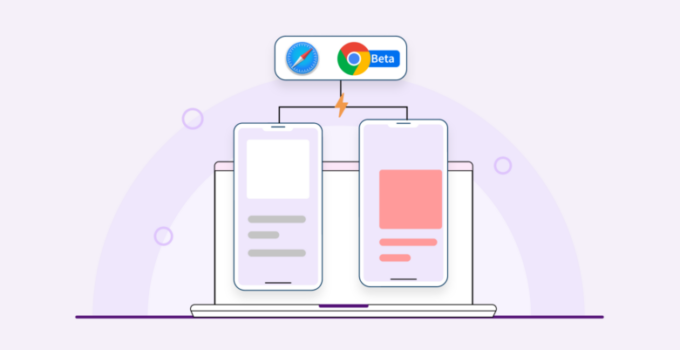In the rapidly evolving world of web development, achieving a uniform user experience across a multitude of browsers and devices presents a formidable challenge. As technology progresses and user expectations soar, the significance of cross-browser testing becomes undeniable. This practice serves as the cornerstone of ensuring that your website or application operates seamlessly, irrespective of the user’s chosen browser or device. Within this guide, we will explore the intricacies of cross-browser testing, shining a spotlight on real device testing, unearthing its advantages, and providing insights into establishing an efficient testing environment.
The Need for Cross-Browser Testing

Source: headspin.io
Cross-browser testing encompasses the meticulous evaluation of a website or application across a spectrum of web browsers and devices to pinpoint compatibility discrepancies. In a landscape teeming with browsers like Chrome, Firefox, Safari, and Edge – each armed with its distinct versions and rendering engines – the complexities of maintaining uniform user experiences become glaringly evident. The complications further amplify when diverse screen sizes, resolutions, and input mechanisms enter the equation.
Imagine a scenario where your exquisitely designed website falters, appearing distorted or non-functional on a specific browser. The repercussions could be dire: diminished user engagement, a tarnished reputation, and ultimately, a detrimental blow to your business’s prospects. This is precisely where the value of cross-browser testing emerges, extending a lifeline to developers by enabling them to identify and rectify issues before they infiltrate the end-users encounters. Since there is a vast range of browsers, operating systems, and devices, it is not affordable for businesses to have this testing infrastructure. However, they can leverage cloud-based browser testing platforms such as https://www.lambdatest.com/online-browser-testing.
Understanding Cross-Browser Testing
Fundamentally, at the heart of cross-browser testing lies the essential process of confirming that a website or application operates precisely as envisioned across an array of browsers. This fundamental procedure assumes pivotal importance in the realm of web development, for it guarantees a uniform and reliable encounter for all users, regardless of their favored browser selection.
The profusion of browsers and devices saturating the market is nothing short of remarkable. Users not only sift through an assortment of renowned browsers but also navigate distinct devices, spanning desktops, laptops, tablets, and smartphones. With each amalgamation of browser and device, a unique set of challenges unfurls, accentuated by variations in screen dimensions, resolutions, and the processing prowess inherent to each.
Traditional methods of testing, such as using emulators and simulators, have limitations. Emulators mimic the behavior of different devices and browsers, but they may not accurately capture the nuances of real-world usage. This is where real device testing comes into play.
Real device testing involves evaluating your website or application on actual devices, such as smartphones and tablets. This approach provides a more accurate representation of user interactions and helps identify issues that may not be evident in emulators. For instance, performance bottlenecks, touch gestures, and device-specific bugs are more likely to be discovered through real device testing.
Benefits of Real Device Testing

Source: perfecto.io
While emulators and simulators offer convenience, they often fall short in replicating real-world scenarios. Real device testing, on the other hand, offers several compelling benefits:
- Accurate Results: Real devices provide a true-to-life environment, enabling you to uncover issues that might not surface in emulators.
- Nuanced Testing: Real device testing captures the subtleties of device-specific behaviors and performance, leading to more accurate results.
- Improved User Experience: Identifying and resolving issues through real device testing contributes to a seamless user experience across all devices and browsers.
- Business Impact: In a competitive digital landscape, a positive user experience can directly impact user engagement, conversion rates, and brand loyalty.
To illustrate the impact of real device testing, consider the case of a popular e-commerce website. Through real device testing, the development team identified a critical bug that affected the checkout process on a specific version of Safari on iOS devices. Prompt action led to a significant reduction in cart abandonment rates and an increase in successful transactions.
Setting Up Your Testing Environment
Before diving into real device testing, it’s important to set up a conducive testing environment. Here are the steps to consider:
- Tools and Resources: Research and select real device testing platforms that offer a wide range of devices and browsers to test on. A digital experience testing platform that provides 3000+ testing environments and real device clouds that can be accessed remotely.
- Device and Browser Selection: Choose a mix of popular devices and browsers that align with your target audience. Consider demographics, user preferences, and market trends.
- Diverse Testing Environment: Aim to replicate your users’ environment as closely as possible. Test on different operating systems, screen sizes, and input methods to ensure comprehensive coverage.
- Test Plans: Develop test plans that outline the specific scenarios and interactions you’ll be testing on each device and browser. This structured approach helps ensure thorough testing.
Preparing Your Website/Application for Testing

Source: usersnap.com
Before embarking on real device testing, it’s crucial to prepare your website or application for the process. Here are some key considerations:
- Optimizing for Testing: Ensure that your codebase is organized, well-documented, and optimized for testing. This includes using clear and semantic HTML, modular CSS, and efficient JavaScript practices.
- Responsive Design: Embrace responsive design principles to ensure your website adapts gracefully to different screen sizes. Utilize media queries and flexible layouts to create a fluid experience.
- Code Validation: Validate your code using tools like W3C Markup Validation Service and CSS validators. Clean, standards-compliant code is less likely to exhibit compatibility issues.
- Third-Party Dependencies: Be mindful of third-party libraries and plugins that might not behave consistently across different browsers and devices. Test them thoroughly during the real device testing phase.
Performing Real Device Tests
Once you’ve set up your testing environment and prepared your website or application, it’s time to dive into performing real device tests. This phase is crucial for identifying compatibility issues and ensuring a seamless user experience across different devices and browsers. Here’s how to navigate the process effectively:
Running Tests on Real Devices:
- Accessing Testing Platforms: Log in to the chosen real device testing platform.
- Selecting Devices and Browsers: Choose the devices and browsers you want to test on based on your target audience. Select a mix of popular options to cover a wide user base.
- Launching the Tests: Start the testing session. This will open a virtual environment where you can interact with the selected devices and browsers as if they were physical devices.
- Navigating the Website/Application: Navigate through your website or application just like a user would. Interact with different elements, click links, fill out forms, and explore various functionalities.
- Recording Observations: Make note of any issues you encounter, such as layout inconsistencies, broken features, or slow performance.
Interacting with Browsers and Reporting Bugs:

Source: kiwiqa.com
- Browser Navigation: Familiarize yourself with the browser’s navigation, such as opening new tabs, accessing bookmarks, and using browser-specific features.
- Inspecting Elements: Use the browser’s built-in developer tools to inspect elements, review code, and debug issues. This is a powerful way to identify the root cause of compatibility problems.
- Documenting Bugs: Whenever you encounter a bug or compatibility issue, document it with detailed steps to reproduce. Include browser and device information for reference.
- Reporting Issues: If you’re testing on a real device testing platform, they often provide a way to report issues directly. Provide screenshots, video recordings, and clear descriptions to aid developers in understanding the problem.
Iterative Testing and Refinement:
- Feedback Loop: Incorporate a feedback loop by addressing reported issues and retesting on real devices. This iterative process ensures that your fixes do not introduce new problems.
- Incremental Improvements: Gradually refine your website or application based on the feedback received during real device testing. This incremental approach leads to a more polished final product.
Analyzing Test Results and Debugging

Source: edukacija.rs
Once you’ve completed the testing phase, the next step is to analyze test results, identify compatibility issues, and debug them effectively. Here’s how to approach this critical stage:
Analyzing Test Results:
- Compile Data: Gather the documented bugs, issues, and observations from the real device testing phase.
- Categorize Issues: Group issues based on their severity and impact on user experience.
- Prioritize Fixes: Prioritize fixes based on the potential impact on user engagement, conversion rates, and overall website/application functionality.
Debugging and Troubleshooting:
- Browser Developer Tools: Leverage browser developer tools to inspect elements, review network requests, and monitor console errors. These tools provide insights into the root causes of compatibility issues.
- Code Review: Carefully review your codebase, paying attention to areas that might cause compatibility problems. Validate your HTML, CSS, and JavaScript to ensure they adhere to standards.
- Simulating User Interactions: Use the browser’s developer tools to simulate user interactions and replicate specific scenarios that led to issues. This helps in reproducing and subsequently fixing problems.
Thorough Testing on Different Devices and Browsers:
- Diversity Matters: Test your website or application on various devices and browsers, covering different operating systems and screen sizes.
- User-Centric Approach: Put yourself in the user’s shoes and test scenarios that align with real-world usage. This user-centric approach is essential for identifying compatibility issues that might impact your audience.
Automation and Continuous Testing

As projects evolve and new features are added, maintaining compatibility becomes an ongoing challenge. Automation and continuous testing play a pivotal role in addressing this challenge:
Automation in Cross-Browser Testing:
- Test Scripts: Create automated test scripts that simulate user interactions and perform repetitive testing tasks.
- Testing Frameworks: Utilize testing frameworks like Selenium, Puppeteer, or Appium to automate interactions across various devices and browsers.
Benefits of Automated Testing Pipelines:
- Efficiency: Automated testing saves time by running tests simultaneously across multiple devices and browsers.
- Consistency: Automated tests ensure consistent test scenarios, reducing human error in manual testing.
- Regression Testing: Automated pipelines help catch regressions introduced by code changes, ensuring existing functionality remains intact.
Tools and Frameworks for Automated Real Device Testing:
- Selenium: A widely-used automation framework that supports various programming languages and browsers.
- Puppeteer: A Node.js library for controlling headless Chrome or Chromium browsers.
- Appium: Designed for mobile applications, Appium supports automation across iOS and Android devices.
Role of Continuous Testing:
- Integration with CI/CD: Integrate automated tests into your continuous integration and continuous delivery (CI/CD) pipelines. This ensures compatibility is maintained with each code change.
Best Practices for Cross-Browser Testing

Source: usersnap.com
As you embark on your cross-browser testing journey, consider these best practices to ensure a thorough and effective testing process:
Key Takeaways and Best Practices:
- User-Centric Approach: Prioritize user experience and usability throughout the testing process.
- Regular Updates: Keep up with browser updates and trends to adapt your testing strategy accordingly.
- Accessibility Testing: Ensure your website or application is accessible to users with disabilities by conducting accessibility testing.
Checklist for Effective Cross-Browser Testing on Real Devices:
- Choose a Diverse Set of Devices: Test on a variety of devices, screen sizes, and browsers.
- Test Common User Scenarios: Focus on scenarios that align with real user interactions.
- Document and Prioritize Issues: Thoroughly document and prioritize identified compatibility issues.
- Iterative Testing: Continuously test and refine based on feedback and fixes.
Prioritizing User Experience and Accessibility:
- Responsive Design: Design and develop with a responsive mindset, ensuring content adapts to different screens seamlessly.
- User Testing: Conduct user testing with diverse participants to gather real-world feedback.
Conclusion:
In the dynamic realm of web development, cross-browser testing on real devices stands as a crucial pillar for delivering a seamless user experience. By embracing real device testing, navigating the intricacies of different browsers and devices, and following best practices, you empower your development process to create a digital product that transcends the boundaries of technology. As the landscape of web technologies continues to evolve, remember that cross-browser testing is not a one-time task but a continuous journey. Adapt, learn, and refine your testing strategy to ensure that your website or application remains accessible and delightful to users, regardless of the browser they choose or the device they hold in their hands.




